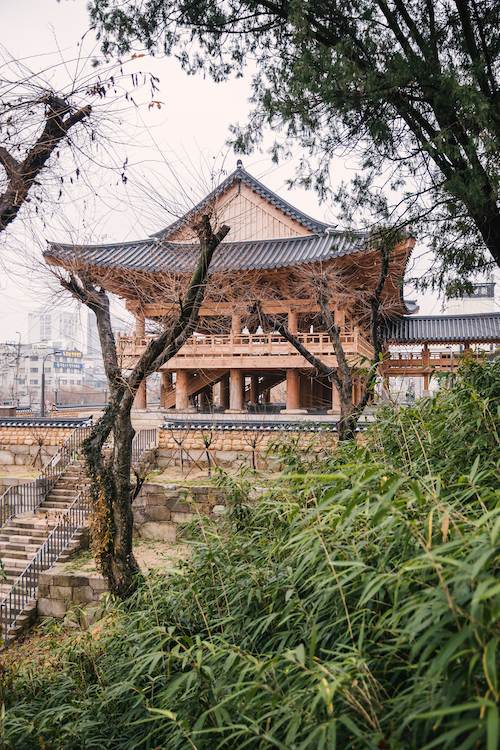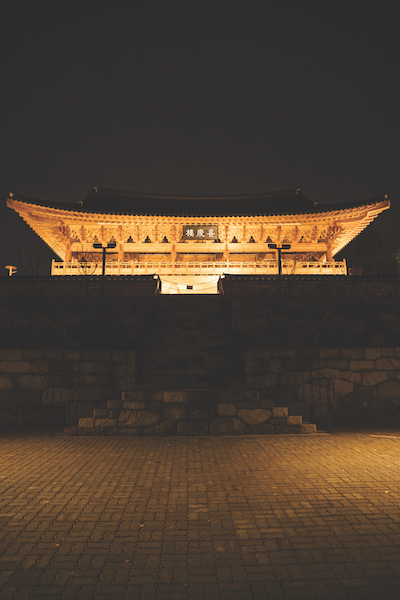Pavilion Huigyeongnu: Bridging Past and Present
By Julien Laheurte
In the year 1451, shortly after assuming the role of governor in Gwangju, the esteemed An Cheol-seok was dismayed to find no suitable venue for official gatherings in the city. Consulting with local elders, he commissioned the construction of a pavilion named Huigyeongnu (희경루), meaning “to rejoice together and celebrate with each other.” This architectural gem was designed to host banquets and festivities for provincial officials and esteemed visitors.
Described by Shin Suk-ju, a future prime minister, as the “widest and most splendid structure in our country,” Huigyeongnu adorned a main road to the east, overlooking a vast field to the west. A pond with lotus flowers graced its northern side, while an archery range in the east served as a place for cultivating virtue. Huigyeongnu became a haven for both hosts and guests, providing a space for leisure and relaxation.
The beauty of Huigyeongnu was immortalized in a 1567 painting titled Huigyeongnu Banghoedo (Gathering at Huigyeongnu Pavilion).

The painting captures a reunion of former classmates who passed the civil service examination together in 1546. Notable figures such as Choi Eung-ryong, governor of Gwangju, Kang Seom, inspector-general of Jeolla Province, and Liu Keug-gong, a military officer in Jeolla Province, gathered after two decades of working in different administrations. The left side of the painting showcases Huigyeongnu, while the right side depicts the surrounding walls and scenery. Participants, donned in headgear reflecting their status, sit in designated positions based on their ranks. Inside Huigyeongnu, a vibrant banquet unfolds with musical performances and dance. This masterpiece (a national treasure since 2015) is currently under the care of Dongguk University.
Highs and Lows
The history of Huigyeongnu, hailed as the “finest pavilion of the east,” has been marked by highs and lows. Destroyed in a fire in 1533, it was reconstructed a year later. Further reconstruction occurred in 1686, only to face disappearance in 1866. The colonial period witnessed the demolition of the Gwangju fortress, erasing all traces of Huigyeongnu’s accurate location. To revive this historically significant pavilion, Gwangju invested six billion won between 2009 and 2018 in a reconstruction project, faithfully recreating its original shape from 1451.
Identifying the original location as the current site of Chungjang Post Office, Gwangju opted to reconstruct Huigyeongnu in Gwangju Park for historical context, accessibility, and project feasibility. Positioned to overlook Mt. Mudeung, the symbol of Gwangju, as well as the vibrant streets of Chungjang-ro and Geumnam-ro, Huigyeongnu is poised to connect with nearby facilities such as the Asia Culture Complex and Gwangju Park. Officials envision it as a central cultural hub, fostering performances and events related to intangible cultural heritage and promoting Gwangju as a city of historical and cultural significance. The reconstruction’s commemorative ceremony, delayed due to frequent rain, finally took place on October 20, 2023, in Gu-dong, Nam-gu.

Between Time and Space
Beyond its historical significance, the new Huigyeongnu is conceived as an operational cultural facility for Gwangju citizens. Since its opening, it has been integrated into the “Gwangju Forest Stroll” (광주목 나드리), an exploration course running from October to November 2023. This initiative aims to guide people through the cultural and historical traces of the city, including Huigyeongnu, Gwangju Park, the five-story stone pagoda at the Seonggeo-sa Temple site, and the Gwangju Hyanggyo (former Confucian school).
Simultaneously, Huigyeongnu played host to the “Gwangju Woodwind and String Ensemble” (광주목 음풍영월), a month-long festival of traditional art and music organized by the Gwangju Cultural Heritage Foundation’s Traditional Cultural Center (from October 18 to November 10). The festival showcased traditional art performances, including pansori and sanjo.
Looking ahead, Gwangju City has ambitious plans to bolster cultural tourism activities in the wake of Huigyeongnu’s reconstruction. The pavilion stands as a testament to Gwangju’s rich heritage, serving as a bridge between time and space, connecting the city’s illustrious past with its vibrant present and promising future.
The Author
Julien Laheurte is a French literary translator who has been residing in South Korea for the past two years. After the completion of his master’s degree in Seoul, he moved to Gwangju with the intention of delving deeper into the history of the May 18 Democracy Movement. His goal is to translate literary works that shed light on this pivotal moment in Korean history.
Instagram: @julien.laheurte







